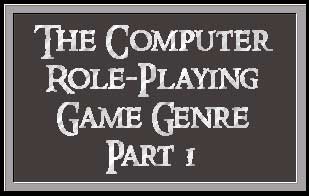
Role-Playing Games like Adventure Games follow the adventures of a player-controlled character or characters. The main difference is that RPGs have a character class system, in which the player's character can improve in power as the character gains experience from the game such as by killing monsters and gaining treasure.
The Computer Role Playing Game (CRPG) genre has been heavily influenced by the original pen & paper role-playing games and has frequently tried to emulate them on a computer. However, the Dungeon Master in pen & paper RPGs was required to adlib the adventure to a considerable degree because role-playing rules have numerous gaps in them and can also suffer from numerous rule inconsistencies and contradictions. The Dungeon Masters direction could also serve to keep the action at the players level and make the adventure more entertaining. The spirit of paper pencil RPGs is to assume the persona of a character in a vast world to explore and give the player the choice to choose what careers or adventures to follow. Some CRPGs have attempted to create such a world in which the player can form his own adventures but this is a very tall order to do in a computer game compared to making a directed adventure with some RPG elements or a dungeon crawl for treasure and character level advancement.
The CRPG genre has seen a mixture of high tech-master pieces, design innovators, and a large number of long running series that are usually way behind the times in technology, which are sold to a loyal group of aficionados. Unfortunately, the industry has treated producing a computer role-playing game of an established role-playing system the same way it does buying a film licence. It gives the game an instant established audience to whom it can be sold and any attempt at design or technical innovation is seen as a waste of time.
Pen & Paper RPGs
 Role-playing
games started with Dungeons & Dragons (D&D) in 1974 when Dave
Arneson and Gary Gygax published Dungeon's and Dragon's the worlds first fantasy
role-playing system. Sometimes the word fantasy is placed in front to differentiate
from such activities as practising job interview techniques! D&D started
life as a fantasy supplement for Gygax's Chainmail medieval wargame
rules to fight the battles found in books such as J. R. R. Tolkien's Hobbit
and Lord of the Rings. The new companies name TSR stood for Tactical Studies
Rules. D&D then rapidly evolved into a game in which
the player took the part of a character in such a fantasy world and with other
characters set about exploring this world. The characters fought monsters
and gained treasure and their reward was for their character to go up in levels
becoming harder to kill and gaining greater skills in fighting monsters.
Role-playing
games started with Dungeons & Dragons (D&D) in 1974 when Dave
Arneson and Gary Gygax published Dungeon's and Dragon's the worlds first fantasy
role-playing system. Sometimes the word fantasy is placed in front to differentiate
from such activities as practising job interview techniques! D&D started
life as a fantasy supplement for Gygax's Chainmail medieval wargame
rules to fight the battles found in books such as J. R. R. Tolkien's Hobbit
and Lord of the Rings. The new companies name TSR stood for Tactical Studies
Rules. D&D then rapidly evolved into a game in which
the player took the part of a character in such a fantasy world and with other
characters set about exploring this world. The characters fought monsters
and gained treasure and their reward was for their character to go up in levels
becoming harder to kill and gaining greater skills in fighting monsters.
Role-playing games required a referee or 'games master' to create the fantasy lands and dungeons and give life to his fantasy world as the players fought their way through it. The games were sometimes played with painted figures on tiled dungeons but most players just preferred to use their imagination. The game was completely open-ended and there was no clear end to the game or any winners or losers. For players part of the fun was making their character more powerful, fighting bigger monsters, getting better treasures to get more experience points to make their player characters increase in level and become more powerful.
The success of TSR's D&D spawned numerous other role-playing games such as Tunnels & Trolls on every subject imaginable. As fantasy role-playing became more popular, it also became more commercial. TSR expanded D&D to Basic/Expert and Advanced Dungeons & Dragons versions. The Advanced version required numerous books and numerous ready-made adventures were made available. TSR brought out Gamma World in 1978, this used the aftermath of a nuclear war as the setting. Role-playing games have included such titles as Call of Cthulhu, DC Heroes, GURPS, Traveller, and Runequest.
The CRPG Originators
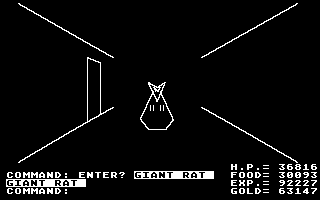 Richard
Garriot's, had created a number of text adventures but his first published
game Akalabeth sold 30,000 copies in 1979, and was a graphical CRPG
for the Apple II. However, Akalabeth was in design terms little different
from the other Adventure games of this period. Ultima published in
1980 had a user interface and more of a plot and was clearly meant to emulate
the dungeon adventures of pen & paper RPGs such as D&D. Richard, his
brother Robert, father Owen, and Chuck Bueche, a programmer at Online-Systems
who were now publishing the series, founded Origin Systems in 1983. The
Ultima sequels concentrated on developing the technology of the engine in
an attempt to increase the size of the market the game could reach. Ultimas
I-III had been partly first-person perspective in a wire frame world or
top down view of flat map world, and on most platforms were black and white.
It was not until Ultima VI published in 1990 was the isometric view
fully developed.
Richard
Garriot's, had created a number of text adventures but his first published
game Akalabeth sold 30,000 copies in 1979, and was a graphical CRPG
for the Apple II. However, Akalabeth was in design terms little different
from the other Adventure games of this period. Ultima published in
1980 had a user interface and more of a plot and was clearly meant to emulate
the dungeon adventures of pen & paper RPGs such as D&D. Richard, his
brother Robert, father Owen, and Chuck Bueche, a programmer at Online-Systems
who were now publishing the series, founded Origin Systems in 1983. The
Ultima sequels concentrated on developing the technology of the engine in
an attempt to increase the size of the market the game could reach. Ultimas
I-III had been partly first-person perspective in a wire frame world or
top down view of flat map world, and on most platforms were black and white.
It was not until Ultima VI published in 1990 was the isometric view
fully developed.
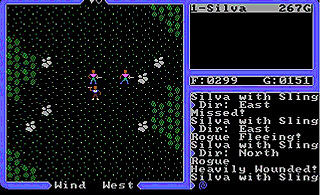 Ultima
IV, Quest of the Avatar published in 1985 introduced a moral dimension
to the series. Garriot had become worried by letters Origin had received that
described Ultima III as a satanic perverter of America's youth. An
anti-role-playing movement had started after two boys suicides had been tenuously
linked to the RPG hobby. Garriot decided his games could affect people or
see things in the game, which was not his intentional message and decided
he had to pay more attention to the games message. Ultima IV made the
player an Avatar for the first time rather than a visitor on an alien planet,
who had to discover virtues and had an invisible Karma meter based on his
actions in the game. The player's karma had to be at a certain level or he
would not be allowed to finish the game. Although Origin, was worried about
the players reaction, they liked the new dimension as the game had gone from
a hack and slash for the plunder to a real role-playing game in which the
player had choices. Ultima was transformed from a hack and slash dungeon exploration
game to a Role-playing game with an epic story line.
Ultima
IV, Quest of the Avatar published in 1985 introduced a moral dimension
to the series. Garriot had become worried by letters Origin had received that
described Ultima III as a satanic perverter of America's youth. An
anti-role-playing movement had started after two boys suicides had been tenuously
linked to the RPG hobby. Garriot decided his games could affect people or
see things in the game, which was not his intentional message and decided
he had to pay more attention to the games message. Ultima IV made the
player an Avatar for the first time rather than a visitor on an alien planet,
who had to discover virtues and had an invisible Karma meter based on his
actions in the game. The player's karma had to be at a certain level or he
would not be allowed to finish the game. Although Origin, was worried about
the players reaction, they liked the new dimension as the game had gone from
a hack and slash for the plunder to a real role-playing game in which the
player had choices. Ultima was transformed from a hack and slash dungeon exploration
game to a Role-playing game with an epic story line.
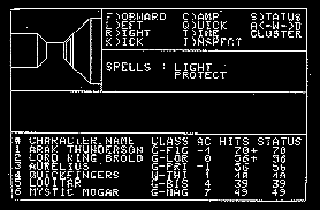 Andrew
Greenberg started to make Wizardry to entertain his friends whilst a student
and teamed up with Robert Woodhead and distributed the game for the first
time at a Boston Computer convention in 1980. One of Greenberg's friends Fred
Norman was hired to computerize the accounting system of Fred Sirotek's construction
company and persuaded him to put up the money to market the game. Sir-Tech
Software - a pun on the Sirotek family name and the fantasy and technological
aspects of the game - published Wizardry: Proving Ground of the Mad Overlord
in 1981.
Andrew
Greenberg started to make Wizardry to entertain his friends whilst a student
and teamed up with Robert Woodhead and distributed the game for the first
time at a Boston Computer convention in 1980. One of Greenberg's friends Fred
Norman was hired to computerize the accounting system of Fred Sirotek's construction
company and persuaded him to put up the money to market the game. Sir-Tech
Software - a pun on the Sirotek family name and the fantasy and technological
aspects of the game - published Wizardry: Proving Ground of the Mad Overlord
in 1981.
Wizardry in many ways was the first computer game that had all the elements of a fantasy pen and paper RPG and used character classes, hit points and experience levels. It was the first game not just to have a single character but recreated the party concept of fantasy RPGs, and player generated six characters to explore the dungeon. Different character classes such as fighters and wizards had different talents and skills and belonged to different fantasy races such as dwarves or elfs.
Wizardry's graphics were wireframe walled corridors in a first person view. Monsters materialized in front of the party and were heralded by a sound on the apples primitive speaker, and a small colour picture of the monster was displayed in the upper left-hand corner of the screen. But for all the seemingly simplicity this system allowed, the dungeons were liberally sprinkled with traps, teleporters design to get the player lost and green slime. Artefact manipulation and combat were turn-based with commands issued through the keyboard. The game plot and puzzles were as deep as any adventure game of its time. The game was constantly played tested in development to get the balance right between all the different elements.
 The
complexity of Wizardry was fitted on a 48K Apple II by building layers of
interpreters, with a top-level interpreter driven off a database defining
the game scenario. It gave a ready scenario and scripting platform for new
game development. Wizardry II-V were technologically almost the same
and could be viewed as add-ons to Wizardry I and were developed between 1983
and 1988. Wizardry was ported to the PC, and these early PC Wizardry's were
all disk booters sold as "scenarios" and all used CGA graphics.
With Wizardry VI, Bane of the Cosmic Force, (1990), Sir-Tech switched
to the PC as primary platform, just as Origin did at the same time with Ultima
VI. Though Wizardry VI featured already slightly outdated EGA graphics, it
was visually a vast improvement.
The
complexity of Wizardry was fitted on a 48K Apple II by building layers of
interpreters, with a top-level interpreter driven off a database defining
the game scenario. It gave a ready scenario and scripting platform for new
game development. Wizardry II-V were technologically almost the same
and could be viewed as add-ons to Wizardry I and were developed between 1983
and 1988. Wizardry was ported to the PC, and these early PC Wizardry's were
all disk booters sold as "scenarios" and all used CGA graphics.
With Wizardry VI, Bane of the Cosmic Force, (1990), Sir-Tech switched
to the PC as primary platform, just as Origin did at the same time with Ultima
VI. Though Wizardry VI featured already slightly outdated EGA graphics, it
was visually a vast improvement.
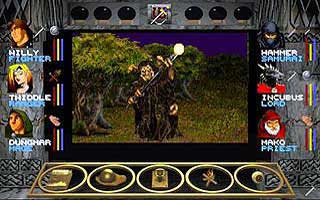 The
high point of the series was Crusaders of the Dark Savant (It is often
known under this title rather than Wizardry VII) released in 1992 with VGA
graphics. Gameplay was little different from Wizardry I and the monsters still
materialized in front of the party. The plot was a mixture of Science Fiction
and fantasy elements and the players weaponry could include lasers and swords.
In 1996, it was re-released on CD with digital speech, new graphics and animations,
and an in-game online hint system as Wizardry Gold. Wizardry VIII
was released nine years later in 2001 and although it had a 3D engine, it
was still not as technically sophisticated as its contemporaries.
The
high point of the series was Crusaders of the Dark Savant (It is often
known under this title rather than Wizardry VII) released in 1992 with VGA
graphics. Gameplay was little different from Wizardry I and the monsters still
materialized in front of the party. The plot was a mixture of Science Fiction
and fantasy elements and the players weaponry could include lasers and swords.
In 1996, it was re-released on CD with digital speech, new graphics and animations,
and an in-game online hint system as Wizardry Gold. Wizardry VIII
was released nine years later in 2001 and although it had a 3D engine, it
was still not as technically sophisticated as its contemporaries.
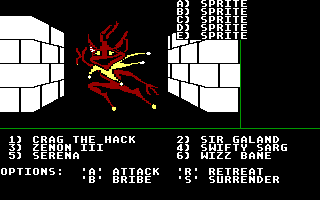 A
whole host of games were made on similar lines to the Wizardry series, these
have included: Might and Magic (1984) and The Bard's Tale (1985).
Might and Magic, Book I: The Secret of the Inner Sanctum was developed
in 1984 for the Apple II-c with full 16 colour EGA support and so had great
graphics for its time and the dungeon hack gameplay was in between the hardcore
Wizardry and Ultima series. The Might and Magic series has been one of the
CRPG most long running and successful and the ninth episode, Might and
Magic IX: Writ of Fate was released in 2002 and introduced a full 3-D
environment featuring first person viewpoint, real time and turn-based combat.
Technologically the series has not kept up with cutting edge of game development
and has increasingly appealed only to aficionados of CRPGs and the series.
A
whole host of games were made on similar lines to the Wizardry series, these
have included: Might and Magic (1984) and The Bard's Tale (1985).
Might and Magic, Book I: The Secret of the Inner Sanctum was developed
in 1984 for the Apple II-c with full 16 colour EGA support and so had great
graphics for its time and the dungeon hack gameplay was in between the hardcore
Wizardry and Ultima series. The Might and Magic series has been one of the
CRPG most long running and successful and the ninth episode, Might and
Magic IX: Writ of Fate was released in 2002 and introduced a full 3-D
environment featuring first person viewpoint, real time and turn-based combat.
Technologically the series has not kept up with cutting edge of game development
and has increasingly appealed only to aficionados of CRPGs and the series.
The Bard's Tale started a series of three, which changed little in technology and ended in 1988 with Bard's Tale III. The Bard's Tale continued Wizardry's first person perspective but added a number of innovations including more characters classes, indoor and outdoor adventuring, and colour graphics. The plot was an adventure to defeat the evil wizard Managar, who had cast an eternal winter on to the city of Skara Brae.
The Computer Fellowship of Dungeons & Dragons
Going back to the development of paper RPGs, TSR in 1978, published the Advanced Dungeons & Dragons rulesets. It had more structure than the original rules and dealt with more situations, character classes, and monsters. From the late '70s to the mid-'80s, AD&D grew in popularity and profits. There was even a Dungeons & Dragoons cartoon aired in the U.S. on Saturday mornings in the mid 1980s. However, during these same years, TSR encountered major financial troubles, but it eventually bounced back when in 1988 it unveiled the 2nd Edition rules for AD&D, a revised AD&D system that streamlined and better organized the AD&D rules.
SSI bought the license to use the official Advanced Dungeons & Dragons rule-sets in the late 1980s. The AD&D franchise has produced more than 20 games more than the Ultima and Might and Magic series combined. Most of the games have been poor designs, have been under par technologically compared to their contemporaries, and were sold purely on their link to the pen and paper game.
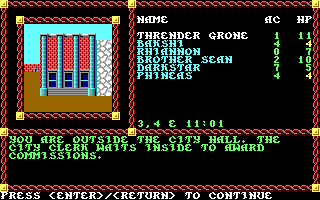 Pool
of Radiance (1988) was the first computer-based role-playing game based
in the AD&D universe in the gold box series. It was based in the Forgotten
Realms universe of an actual AD&D campaign module, Ruins of Adventure.
The player controlled a mercenary party of up to six characters, with two
slots open for Non Player Characters (NPCs). The game was limited in that
it used only four AD&D character classes (fighter, magic-user, cleric
and thief) and had a relatively low character level cap. Some of the games
art was based on illustrations in the official Monster Manual. The game was
set in the main Forgotten Realms backdrop of AD&D and was followed up
with three sequels.
Pool
of Radiance (1988) was the first computer-based role-playing game based
in the AD&D universe in the gold box series. It was based in the Forgotten
Realms universe of an actual AD&D campaign module, Ruins of Adventure.
The player controlled a mercenary party of up to six characters, with two
slots open for Non Player Characters (NPCs). The game was limited in that
it used only four AD&D character classes (fighter, magic-user, cleric
and thief) and had a relatively low character level cap. Some of the games
art was based on illustrations in the official Monster Manual. The game was
set in the main Forgotten Realms backdrop of AD&D and was followed up
with three sequels.
As TSR published more and more modules set in different fantasy settings, SSI was ready to develop a CRPG set in them as well. SSI made use of the gothic horror setting of Ravenloft, the desert lands of Dark, and even set games in two obscure settings, of Al-Qadim inspired by the tales of the Arabian Nights and the fantasy outer-space world of Spelljammer. The incredibly popular Dragonlance series of books and adventure modules was brought to the computer in a series of nine games released between 1988 and 1994. The first, Heroes of the Lance was an unimaginative side-scroller platform game masquerading as a true CRPG.
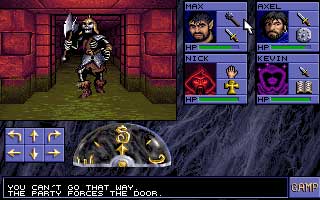 One
of the better SSI CRPGs, Eye of the Beholder, was released in 1991,
and although it had new features for an SSI game they had all been pioneered
by other fantasy CRPGs such as Dungeon Master. Eye of the Beholder
was the first A&DD game to have a fully first-person perspective and sported
a newly designed interface. Instead of sets of abstract lists, characters
had paper-doll inventory screens upon which they could equip their weapons
and armour. The game had some design problems, encounters took place in pseudo-real-time
but the narrow, one-directional line of sight meant the monsters could get
free hits on the party from blind spots at the sides and rear. There was a
cumbersome swapping of weapons and items from hand to backpack. The final
monster, Xanathar the Beholder, required all the characters to be at maximum
levels for the party to have a chance of defeating him. There was also no
proper ending sequence to reward the player's efforts for finishing the game.
The game was followed up with two sequels, which technologically and in design
were little different.
One
of the better SSI CRPGs, Eye of the Beholder, was released in 1991,
and although it had new features for an SSI game they had all been pioneered
by other fantasy CRPGs such as Dungeon Master. Eye of the Beholder
was the first A&DD game to have a fully first-person perspective and sported
a newly designed interface. Instead of sets of abstract lists, characters
had paper-doll inventory screens upon which they could equip their weapons
and armour. The game had some design problems, encounters took place in pseudo-real-time
but the narrow, one-directional line of sight meant the monsters could get
free hits on the party from blind spots at the sides and rear. There was a
cumbersome swapping of weapons and items from hand to backpack. The final
monster, Xanathar the Beholder, required all the characters to be at maximum
levels for the party to have a chance of defeating him. There was also no
proper ending sequence to reward the player's efforts for finishing the game.
The game was followed up with two sequels, which technologically and in design
were little different.
The quality of AD&D CRPGs produced by SSI steadily fell and in 1995 with demand for D&D and the genre at low point they decided to concentrate on wargames and gave up the AD&D license. TSR also found its market for the pen & paper version of D&D dwindling when the Magic the Gathering card game became extremely popular in the mid-'90s. TSR tried to respond by releasing its own card game - Spellfire and a collectable dice game - Dragon Dice which was made into a computer game in 1997, but despite pouring money into its new products could not make them popular and went bankrupt trying to outdo Wizards of the Coast.
The New Ring Bearers
Outside of the AD&D licence the early 90s saw a number of radical designs and technological developments in how CRPGs were made.
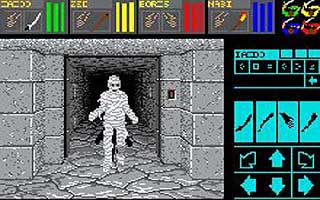 FTL's
Dungeon Master released in 1989 went back to a first-person perspective
and had a very well designed interface to allow a party of four to have a
dungeon crawl. Although, other games at the time looked better, its easy to
use interface, great sound effects, depth of play and real time play led to
an immersive experience that made it one of the best games of its time. Its
role-playing features included many new races and the player had to keep an
eye on the party's hunger levels. The real-time element allowed monsters to
ambush the player's party and the puzzles were well thought out and made the
game more than just a mere hack and slash experience.
FTL's
Dungeon Master released in 1989 went back to a first-person perspective
and had a very well designed interface to allow a party of four to have a
dungeon crawl. Although, other games at the time looked better, its easy to
use interface, great sound effects, depth of play and real time play led to
an immersive experience that made it one of the best games of its time. Its
role-playing features included many new races and the player had to keep an
eye on the party's hunger levels. The real-time element allowed monsters to
ambush the player's party and the puzzles were well thought out and made the
game more than just a mere hack and slash experience.
 Microprose's
Darklands (1991) according to the management actually managed to bring
the company to its knees, who were more used to publishing flight-sims. It
had been expensive to develop and to publish as it came on many floppy disks,
needed a high specification PC for the time to run and went through seven
patches. The game was also let down by numerous bugs, never fully fixed in
the many patches. However, Darklands broke new ground
from the point of view of CRPG design and many of its features were used in
many later games. (Although many such features were common in pen & paper
or tabletop miniature systems of this time.) Darklands was set in an original
fantasy world, that of historical medieval Germany. Instead of magic, the
game used alchemy. Unlike other games in which clerics are just a different
character class, religion and prayer are an authentic and important part of
the game. The game world was extremely detailed with a huge map with over
90 cities to explore, its own calendar system and currency. There were a large
number of different weapon and armour types modelled including their corresponding
weights and effectiveness. The effect of all this detail was to make the game
very immersive.
Microprose's
Darklands (1991) according to the management actually managed to bring
the company to its knees, who were more used to publishing flight-sims. It
had been expensive to develop and to publish as it came on many floppy disks,
needed a high specification PC for the time to run and went through seven
patches. The game was also let down by numerous bugs, never fully fixed in
the many patches. However, Darklands broke new ground
from the point of view of CRPG design and many of its features were used in
many later games. (Although many such features were common in pen & paper
or tabletop miniature systems of this time.) Darklands was set in an original
fantasy world, that of historical medieval Germany. Instead of magic, the
game used alchemy. Unlike other games in which clerics are just a different
character class, religion and prayer are an authentic and important part of
the game. The game world was extremely detailed with a huge map with over
90 cities to explore, its own calendar system and currency. There were a large
number of different weapon and armour types modelled including their corresponding
weights and effectiveness. The effect of all this detail was to make the game
very immersive.
Darklands' character generation was very detailed. The player chooses a name and gender, then select the character's hereditary, which affects the characters stats and skills. The character starts at age 10 and the player picks an occupation, which adds 5 years to the characters age and increases his skills depending on the occupation chosen. The player can keep choosing more careers. However, the character ages during the game and his strength rating and fighting ability will eventually be reduced from old age.
Game movement used a system borrowed from miniature wargame campaigns. The travel screen is map of Germany with a lone figure representing the player's party. For combat with encounters and dungeonering, there was an isometric view similar to the wargames table. Combat was in real time, but the player could pause the action to give orders, making it pseudo-turn based.
Perhaps most impressively the game tried to capture the epic nature of RPGs. The games goal was simply to become famous and was non-linear, with different quests being spawned partly on the players level of fame. Quests included defeating a robber baron, dragons, drive out witches, "knockers" in the mines or more mundanely retrieve relics or stolen papers. The ultimate quest is the fight against the Templar knights, and their demon lord, Baphomet. However, after the player vanquishes Baphomet, he is treated to a small victory screen, and is then given the option to keep on playing. However, I do not think Darklands fully carried off its epic intentions. The size of the world to explore was possibly too ambitious, there was hardly any character interaction, the random quests were very similar and even the few manually created dungeons were little different from the random ones.
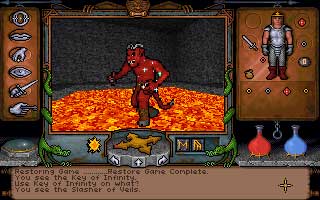 Ultima
Underworld: The Stygian Abyss (1992) with its virtual reality sensation
dropped jaws when it was released. Ultima Underworld was the first game in
true 3D just beating the simpler Wolfstein 3-D to the post. The first-person
perspective view used multi-directional scrolling in real time, rather than
the usual turn-based by flick scrolling with limited 90 degree turns on a
square plan and was similar to a flight simulator. Paul
Neurath after working on a pre-Wing Commander ORIGIN Systems game called Space
Rogue, thought he could knit the space-flight tactics and ground based role-playing
system together. Neurath's new company was called Blue Sky Productions and
set up in Salem, New Hampshire. Doug Wike an ex-ORIGIN artist was employed
to do the concept art work. Chris Green, an IBM PC programmer developed the
programme to do the texture mapping. Most of the programming team were fresh
out of college and new to game writing and improvised greatly, the result
was fresh and impressive. Doug Church a MIT graduate was one of several members
pulled in from the infamous "house of the 10 dumb guys" and later
became project director. Church took a demo to the May 1990 Consumer Electronic
Show. This interested ORIGIN Systems who signed a deal and the game went from
being Underworld to Ultima Underworld.
Ultima
Underworld: The Stygian Abyss (1992) with its virtual reality sensation
dropped jaws when it was released. Ultima Underworld was the first game in
true 3D just beating the simpler Wolfstein 3-D to the post. The first-person
perspective view used multi-directional scrolling in real time, rather than
the usual turn-based by flick scrolling with limited 90 degree turns on a
square plan and was similar to a flight simulator. Paul
Neurath after working on a pre-Wing Commander ORIGIN Systems game called Space
Rogue, thought he could knit the space-flight tactics and ground based role-playing
system together. Neurath's new company was called Blue Sky Productions and
set up in Salem, New Hampshire. Doug Wike an ex-ORIGIN artist was employed
to do the concept art work. Chris Green, an IBM PC programmer developed the
programme to do the texture mapping. Most of the programming team were fresh
out of college and new to game writing and improvised greatly, the result
was fresh and impressive. Doug Church a MIT graduate was one of several members
pulled in from the infamous "house of the 10 dumb guys" and later
became project director. Church took a demo to the May 1990 Consumer Electronic
Show. This interested ORIGIN Systems who signed a deal and the game went from
being Underworld to Ultima Underworld.
Two separate ORIGIN producers assigned to the Underworld project left the team in contact limbo. One producer was gone from ORIGIN a month before Neurath was even told. Warren Spector who had real enthusiasm for the project eventually wrangled the role of producer, without him Underworld might not have seen the light of day. (Such problems are common in the game production process.)
There were a number of innovations in the actual game play. The traditional turn-based system was replaced by a dynamic form of melee in which the player rained down blows with mouse clicks. The interface looks in many ways like that of the original Wizardry. The main view windows handled almost all task with mouse clicks such as picking up armour and putting it on the character, or rummaging in his backpack. The linear and often illogical puzzles of standard CRPGs were replaced with geographically based problem solving. The player could combine items to make new ones by dragging one on top of the other. The standard game fare of the plot, talking to characters, finding items were all well thought out. The total effect was to actual put the player in the dungeon, which became a real-world to the player, which is exactly what RPG's are trying to capture.
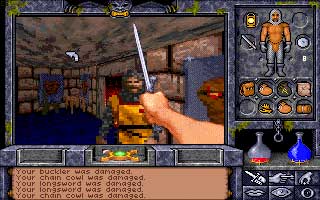 The
game despite its heavy hardware requirements, which limited it to high end
PCs, sold roughly half a million copies. Ultima Underworld 2: Labyrinth
of Worlds (1992), which had a slightly bigger world view in the interface,
rapidly followed the original. Neurath and Spector and other members of the
team separated but would work on other games such as System Shock (1994),
Thief: The Dark Project (1998), and Deus Ex (2000). The game-play
of Underworld was never followed up as sales of the simpler Doom were much
greater and interest lay in making fast action games and shooters not the
complexity of creating a world like Underworld. However, the Underworlds made
later flick-scrolling RPGs such as Dungeon Master II (1994) and Stonekeep
(1995) feel dated.
The
game despite its heavy hardware requirements, which limited it to high end
PCs, sold roughly half a million copies. Ultima Underworld 2: Labyrinth
of Worlds (1992), which had a slightly bigger world view in the interface,
rapidly followed the original. Neurath and Spector and other members of the
team separated but would work on other games such as System Shock (1994),
Thief: The Dark Project (1998), and Deus Ex (2000). The game-play
of Underworld was never followed up as sales of the simpler Doom were much
greater and interest lay in making fast action games and shooters not the
complexity of creating a world like Underworld. However, the Underworlds made
later flick-scrolling RPGs such as Dungeon Master II (1994) and Stonekeep
(1995) feel dated.
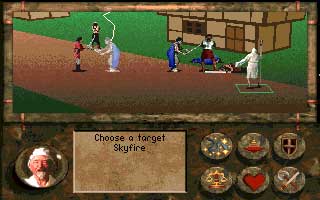 Dynamix's
Betrayal at Krondor published in 1993 was based on the fantasy novels
of Raymond E. Feist and was set in his Riftwar saga. Feist later wrote a book
that loosely followed the plot of the game and apparently had considerable
input into the games plot. The game did not become popular until it was put
on CD-ROM and the price was cut back to clear stocks, and suddenly became
a best seller. Betrayal at Krondor was played in nine chapters or parts with
a distinct story-line and objectives for the player, but the player had a
vast fantasyland to explore and many subquests to do, whilst achieving these
objectives. The objectives of the chapters and clever placement of the monsters
helped guide the player. The player had control of a pair of characters per
chapter, which could be changed. Although the player's characters could be
killed off by the story-line as can heroes be killed off in Feist's books,
the characters developed in power role-playing fashion as the game progressed.
The game had a number of failings and the attempt at making a game with the
story style of a book was sometimes a bit thin, the game was some how much
greater than its parts.
Dynamix's
Betrayal at Krondor published in 1993 was based on the fantasy novels
of Raymond E. Feist and was set in his Riftwar saga. Feist later wrote a book
that loosely followed the plot of the game and apparently had considerable
input into the games plot. The game did not become popular until it was put
on CD-ROM and the price was cut back to clear stocks, and suddenly became
a best seller. Betrayal at Krondor was played in nine chapters or parts with
a distinct story-line and objectives for the player, but the player had a
vast fantasyland to explore and many subquests to do, whilst achieving these
objectives. The objectives of the chapters and clever placement of the monsters
helped guide the player. The player had control of a pair of characters per
chapter, which could be changed. Although the player's characters could be
killed off by the story-line as can heroes be killed off in Feist's books,
the characters developed in power role-playing fashion as the game progressed.
The game had a number of failings and the attempt at making a game with the
story style of a book was sometimes a bit thin, the game was some how much
greater than its parts.
The digitised scanning of actors in costume was probably meant to be a major innovation and selling point, however the costumes and false beards were very poor and garish and is the games worse feature. The game interface used a mix of first person perspective to see the terrain and third person to view combat. The game engine allowed vast exploration of vast open areas, with no loading times except when a chapter switched. To do this the 3D world was polygonal with triangular hills with simple sprites used for objects such as trees. Although the graphics were simple, they were effective in making a believable world. Time passed in the game so that a game day roughly passed in an hour of real time. This meant time passed and the player healed and could encounter random monsters even if he just stood still.
The interface included a helpful overhead map but the player could also view a larger map to see his position in the world. The inventory system was simple and polished, with excellent descriptions for every item in the game. The combat system was simpler than in other CRPGs, which was possibly just as well as enemies in certain locations are encountered extremely frequently. The game set the battlefield for the terrain of the area in which the character had encountered enemies and placed a grid over it, which is used to plot attacks. The magic system was well thought and spells were less powerful and more balanced than in some other systems. Riddle chests were an original idea on the usual take of tricks and traps.
There were some original gameplay design additions in the area of management of food and items. Characters had to consume food, which could go bad or turn out to be poisoned. The player had to carefully balance his budget to cover essentials like food as well as upgrading weaponry and armour. Armour and weaponry also had to be cared for, and characters ability to sharpen his sword, had an ability level, which would occasionally rise after successfully repairing an item. Repairing items also consumes items that can run out. The effect was to keep the player busy and to add an extra realistic dimension on top of slay the monsters and steal their treasure.
Sierra made Betrayal at Krondor freeware in 1997 to promote their own sequel Betrayal at Antara (1997), which was made by another team, without Feist' s input, was a poor imitation of its predecessor.
 Bethsada
Softwork's Elder-Scrolls series of games was one of the few to actually attempt
to create a full fantasy world to explore and fantasy life with a real-time
first person perspective similar to Underworld's. Elder Scrolls: The Arena
was released in 1993, it was technically a big leap forward from Underworld
as the player could traverse vast areas of open area, something the Underworld
engine could not do. This huge 3-D world had over 400 cities, towns and villages
to explore in 8 million kilometers of terrain and also had a day and night,
seasons and weather in which it could rain and snow. Like all the Elder-Scroll
game the character creation process was very detailed and even offered more
than one way to create a character. The user interface was not very intuitive
and involved switching between several screens to review little pieces of
information. Bugs also plagued the game.
Bethsada
Softwork's Elder-Scrolls series of games was one of the few to actually attempt
to create a full fantasy world to explore and fantasy life with a real-time
first person perspective similar to Underworld's. Elder Scrolls: The Arena
was released in 1993, it was technically a big leap forward from Underworld
as the player could traverse vast areas of open area, something the Underworld
engine could not do. This huge 3-D world had over 400 cities, towns and villages
to explore in 8 million kilometers of terrain and also had a day and night,
seasons and weather in which it could rain and snow. Like all the Elder-Scroll
game the character creation process was very detailed and even offered more
than one way to create a character. The user interface was not very intuitive
and involved switching between several screens to review little pieces of
information. Bugs also plagued the game.
The games plot was to rescue the Emperor from his dimensional prison by recovering the eight pieces of the Staff of Chaos. This was linear in that to advance the plot the player had to accomplish certain specific goals in a certain specific order and these goals are all the same goal, repeated eight times. There were no multiple ways to solve a problem included in the design, so if the player cannot solve a riddle to get through a door in which a needed item is located, the game will not advance. If the game is played again from the start, the quest items will appear in different locations, but that is not sufficient to make the game interesting enough to start again. Non-player Character interaction largely involved a generic choice of questions which tended to make the world feel very generic. This generic nature made exploration away from the plot unsatisfying. The vast world of Arena was probably just too big and many players probably became frustrated by it and just gave-up.
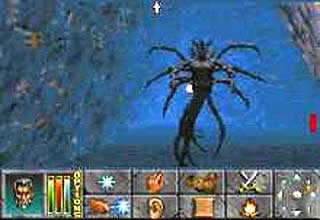 Elder
Scrolls: Daggerfall (1996) was the second in the series, and was even
more epic in scope. The fantasy world of Tamriel encompassed millions of square
miles, a dozen countries each with a culture of their own, has life-sized
towns, huge dungeons bigger than any other game and introduced playable underwater
areas. The world also has seasons and when winter comes, the landscape becomes
snow covered. The design is similar to Darklands, there is a main quest
and when completed the game does not end but allows the player to go on adventuring.
It is much less linear than the Arena and basically allows the player to create
a fantasy character and lead his life.
Elder
Scrolls: Daggerfall (1996) was the second in the series, and was even
more epic in scope. The fantasy world of Tamriel encompassed millions of square
miles, a dozen countries each with a culture of their own, has life-sized
towns, huge dungeons bigger than any other game and introduced playable underwater
areas. The world also has seasons and when winter comes, the landscape becomes
snow covered. The design is similar to Darklands, there is a main quest
and when completed the game does not end but allows the player to go on adventuring.
It is much less linear than the Arena and basically allows the player to create
a fantasy character and lead his life.
The character generation system was extremely detailed and was almost a game in itself, with a massive choice of classes and races linked to the fantasy world. The player even had the option to make his own class includes the options to add special advantages and disadvantages such as phobias, resistances, and specialties. The game does not use the typical D&D style experience points level but instead the skills the character uses are the ones that increase. So if the player's character climbs up walls, then his climbing skill will increase. There are also 27 different skills that a character can learn and use in the game, ranging from essential to the frivolous. The spell system allowed the player to buy default spells, or make new ones and enchant items and was the first fantasy CRPG to offer this feature. The player could even buy a horse and cart to help remove treasure from dungeons, buy a house to use as a safe base or a ship to sail around the coast line.
A main building block of the sub-quest system are the guilds to join, that are not just the normal selection of Thieves, Warriors, Mages and Assassins guilds but religious and knightly orders that vary from country to country. These offer sub quests that are about 45% dungeon-crawls for an item. Most NPCs are randomly generated every time the players character enter a town, and just wonder around although the player can not get into conversation with them, he can steal from them and get into fights with them. NPCs connected to quests or plots are static and are represented by a single pixilated picture that is occasionally animated, and they do not fight. Conversation with these characters is more complex than Arena's stock cloned questions and replies. There are problems with the game balance and mechanics, players can exploit the character system so that after 10th level the game loses any challenge.
The epic nature of the game, which sets it apart from so many other CRPGs, is also part of its downfall. The player just cannot hope to explore all the world and together with the oversize random dungeons makes completing even a single sub-quest no mean feat. Few players could follow the long, intricate main plot. The game was very buggy and this effected completion of the main plot very badly. When, Bethesda discontinued the support for this game in 1998, it was still extremely unstable. Most Players just gave up from being frustrated and overwhelmed.
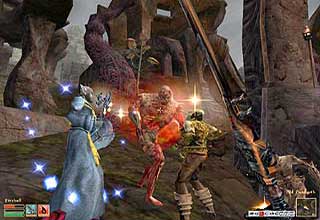 The
Elder Scrolls III: Morrowind (2002) was the third in the series and has
had two expansion packs developed for it, Tribunal and Bloodmoon.
Although as the game has the same problems as Daggerfall I am not sure why
and how many players have actually stayed the course and completed the game
and the expansion packs. The graphics are excellent and it comes with an editor
that players can use to create their own quests. Game play is as before, there
is a main plot on the Island of Vvardenfell to solve an ancient prophecy or
join various guilds and follow the life of your characters class. Morrowind
again has a massive and detailed world to explore. It has all the same problems
that made the previous games a frustrating experience and still comes with
a ton of bugs.
The
Elder Scrolls III: Morrowind (2002) was the third in the series and has
had two expansion packs developed for it, Tribunal and Bloodmoon.
Although as the game has the same problems as Daggerfall I am not sure why
and how many players have actually stayed the course and completed the game
and the expansion packs. The graphics are excellent and it comes with an editor
that players can use to create their own quests. Game play is as before, there
is a main plot on the Island of Vvardenfell to solve an ancient prophecy or
join various guilds and follow the life of your characters class. Morrowind
again has a massive and detailed world to explore. It has all the same problems
that made the previous games a frustrating experience and still comes with
a ton of bugs.
Despite a detailed Character class system, the players character can pick up any skill or ability used by any other class. Game balance is still poor with players finding it all too easy by they time they get to the 10th level. NPCs are generic and just stand or walk around randomly. There is no speech and NPC always give exactly the same, detailed descriptions about the world. Most players, who soon lose the main plot, consider the quests repetitive and boring. The Combat system is just an exchange of strikes or spells, until one combatant dies. (A patch did make the enemy's health visible.)
The series should be brilliant, carrying off the holy grail of CRPGs by making a full, non-linear world for the player to explore and lead a fantasy life. However, major design problems made the game-play frustrating, overwhelming and even boring.
Copyright: 1998 and 2004 Mark Gallear
